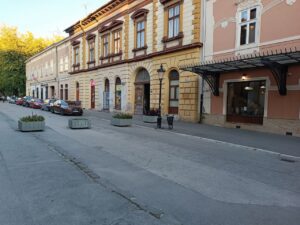The role of Art Nouveau in shaping the architectural appearance of Subotica.
Art Nouveau, a movement that emerged in the late 19th century, is characterized by its organic forms, intricate details, and a harmonious blend of art and architecture. This style found a unique expression in various European cities, and Subotica, a town in northern Serbia, stands out as a remarkable example of Art Nouveau architecture. The influence of this movement has significantly shaped the architectural landscape of Subotica, creating a distinctive identity that reflects both the cultural aspirations and the socio-economic conditions of the time. This article explores the role of Art Nouveau in shaping the architectural appearance of Subotica, highlighting its historical context, key architectural features, and lasting impact on the town’s urban fabric.
Historical Context of Art Nouveau in Subotica
The late 19th and early 20th centuries marked a period of rapid industrialization and urbanization across Europe, and Subotica was no exception. As a thriving town within the Austro-Hungarian Empire, it experienced significant economic growth, which led to an influx of wealth and a burgeoning middle class. This socio-economic transformation created a demand for new architectural styles that could reflect the aspirations of its citizens. Art Nouveau emerged as a response to the rigid forms of historicism, offering a fresh aesthetic that emphasized creativity, craftsmanship, and the beauty of nature.
In Subotica, the Art Nouveau movement was particularly influenced by the broader trends in Europe, including the works of architects such as Victor Horta in Belgium and Hector Guimard in France. The town’s architectural evolution was further shaped by local artisans and architects who embraced the principles of Art Nouveau, integrating them into their designs. This period saw the construction of several iconic buildings that showcased the movement’s distinctive characteristics, such as flowing lines, floral motifs, and elaborate decorative elements, which collectively contributed to the town’s unique architectural identity.
The establishment of the Subotica Art Nouveau Society in the early 20th century played a crucial role in promoting this architectural style. The society aimed to foster a sense of community among artists, architects, and craftsmen, encouraging collaboration and innovation. This collective effort resulted in the creation of numerous buildings that not only embodied the aesthetic ideals of Art Nouveau but also served as cultural landmarks, reflecting the town’s aspirations for modernity and artistic expression.
Key Architectural Features of Art Nouveau in Subotica
Art Nouveau architecture in Subotica is characterized by its distinctive features that set it apart from other architectural styles. One of the most prominent elements is the use of organic forms and flowing lines, which can be seen in the facades of many buildings. These curvilinear designs often mimic natural shapes, such as plants and flowers, creating a sense of harmony between the built environment and nature. The incorporation of decorative motifs, including wrought ironwork and stained glass, further enhances the visual appeal of these structures, making them stand out in the urban landscape.
Another significant aspect of Art Nouveau in Subotica is the emphasis on craftsmanship and attention to detail. Many buildings from this period showcase intricate tile work, ornamental plastering, and hand-painted decorations, reflecting the skill and artistry of local craftsmen. This dedication to quality and aesthetics not only elevates the architectural experience but also serves as a testament to the cultural values of the time, where art was seen as an integral part of everyday life.
Prominent examples of Art Nouveau architecture in Subotica include the City Hall, designed by architect Ferenc Raichle, and the Synagogue, which features stunning decorative elements and a unique blend of styles. These buildings not only serve functional purposes but also act as cultural symbols, representing the town’s rich history and artistic heritage. The architectural beauty of Subotica, shaped by the principles of Art Nouveau, continues to attract visitors and scholars alike, highlighting the enduring legacy of this artistic movement.
Lasting Impact of Art Nouveau on Subotica’s Urban Fabric
The influence of Art Nouveau on Subotica’s architectural landscape extends beyond individual buildings; it has significantly shaped the town’s urban fabric. The harmonious integration of Art Nouveau structures within the existing urban environment has created a cohesive aesthetic that enhances the overall character of Subotica. This architectural style has contributed to the town’s identity, making it a unique destination for those interested in cultural heritage and architectural history.
As a result of its rich Art Nouveau heritage, Subotica has become a focal point for architectural tourism. Visitors are drawn to the town not only for its historical significance but also for the opportunity to experience the beauty of its buildings firsthand. The preservation and promotion of these architectural treasures have become essential for local authorities and cultural organizations, ensuring that future generations can appreciate the artistic achievements of the past.
Moreover, the legacy of Art Nouveau in Subotica has inspired contemporary architects and designers to explore the principles of this movement in their work. The emphasis on craftsmanship, organic forms, and the integration of art into architecture continues to resonate in modern design practices. This ongoing dialogue between the past and present highlights the enduring relevance of Art Nouveau, as it continues to shape the architectural narrative of Subotica and beyond.
In conclusion, Art Nouveau has played a pivotal role in shaping the architectural appearance of Subotica, leaving an indelible mark on the town’s identity. The historical context of the movement, characterized by socio-economic transformation and artistic collaboration, set the stage for the emergence of unique architectural features that define the town’s landscape. The lasting impact of Art Nouveau is evident not only in the preservation of its buildings but also in the ongoing appreciation for craftsmanship and artistic expression in contemporary architecture. As Subotica continues to celebrate its rich architectural heritage, the legacy of Art Nouveau remains a vital part of its cultural narrative, inviting future generations to explore and cherish its artistic achievements.


